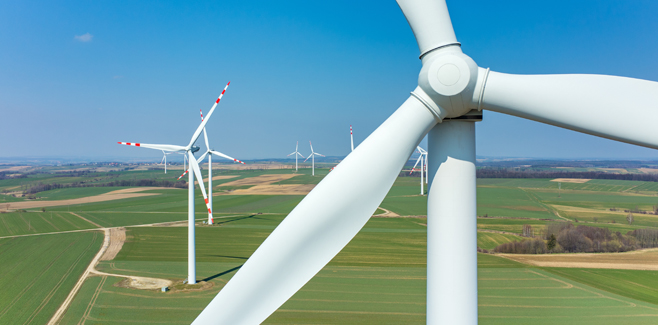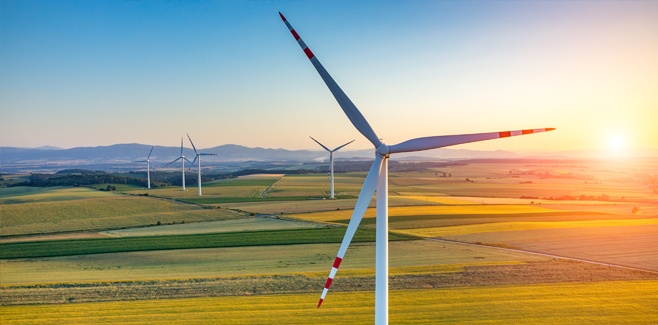Unleash your growth potential by insourcing wind O&M
Global wind power capacity increased to over 744 GW in 2020. To serve the rapidly growing needs of wind fleet owners and operators, wind turbine generator (WTG) OEMs have developed the specialized and profitable discipline of providing WTG O&M services. Many wind park owners and operators have opted to take advantage of this offering and outsource their O&M activities to OEMs through performance warranties coupled with full-service contracts – often at costs upwards of US$60K per WTG/per year for the life of the contract.
However, the availability and competitive cost of modern asset performance management (APM) tools supported by artificial intelligence (AI), have led many to rethink their O&M outsourcing decisions. Larger owners and operators often have mature internal O&M functions, which makes the adoption of APM solutions a natural extension of their operations. Smaller wind turbine owners and operators with limited fleet sizes can also take advantage of APM solutions to augment their O&M capabilities and bring that function wholly in-house. Indeed, wind owners and operators of all sizes are taking their destiny back by insourcing O&M activities – for five primary reasons – as described below.
1. You know your assets best
Leading OEMs currently oversee the largest installed base of wind turbines and can legitimately claim to have access to the “most data” to inform O&M strategies. However, data volume does not always equate to data quality. OEMs may not have access to specific data of your wind fleet such as local wind and site conditions, O&M history and preferences, or OEM portfolio mix – all of which ultimately affect the quality of your O&M decision making. Also, most data do not take into consideration the institutional knowledge from your O&M team’s experience in the field.
For an example of how blanket OEM data is often insufficient to make operational decisions, we can look at the events that occurred in Texas's electrical grid in the US. The 2021 WTG freezing challenges that contributed to a regional, days-long black-out were not sufficiently forecasted by global averages in WTG icing rates supplied by the OEM. The Texas Interconnection owners and operators would have benefitted from a system that drew on actual data from their systems combined with the experience and site-specific knowledge of their local field crews. The kind of data at the heart of APM systems. Independent third-party APM software solutions built specifically for wind turbines allow precise malfunction forecasts by tailoring prognostics to your specific assets – regardless of which OEM produced the assets. Leading solutions, such as Hitachi Energy’ Lumada APM, allow organizations to combine field service and O&M management data with expert knowledge and experience as inputs that prognosticate the health of your specific assets and their most critical components. This approach is far more powerful and accurate than the APM models from most OEMs that apply more generally across a wide array of turbines. You know your assets best and insourcing O&M can give you full control of how asset health is prognosticated, resulting in the most accurate data to make strategic decisions.
2. The hidden cost of performance warranty exclusions
The world’s top 3 WTG OEMs are pure-wind players. Because their core competency lies in WTG manufacturing, their performance warranties typically stop at WTG outgoing power export cables and don’t include the most critical components in your system: the substations.
Avoiding downtime of wind substations should be the first priority for every wind owner and operator because preventing downtime for substations prevents 100% of unexpected lost production. Compare that to unexpected downtime of one 6 MW WTG in a 300 MW wind park that results in just 2% of lost production.
One of the reasons that substations are often overlooked in performance warranties is because substations are not the core business of wind OEMs. In contrast to WTGs, substations have few or no rotating components and many OEMs argue that only rotating components need to be protected. Experienced owners and operators know that this is a dangerous stance because substations are the most critical assets in their systems. Maintaining substation uptime is a basic component of O&M strategy and excluding substations from performance warranties can leave systems – and their operators – vulnerable.
Another common practice that increases risk exposure is the tendency to exclude other generation assets from the APM solution. Overall asset performance in your portfolio may be determined by solar, hydro or conventional power assets, not only wind parks. The best third-party APM solutions cover your entire asset portfolio – from WTGs to substation equipment to non-wind renewables to conventional generation assets – regardless of the manufacturer.
3. Sustainable wind O&M philosophies take a long-term view
The duration of most “full-service” wind O&M contracts offered by WTG OEMs is between two and five years. In these offerings, OEMs have two primary incentives: to optimize asset up-time and to maximize availability or yield. The cost to the OEM to optimize up-time comes at lower cost for the first two to five years when components are new and tactics such as increasing lubrication of the gearboxes can help WTGs maintain contracted output. However, due to their relatively short term, these contracts do not always represent the best long-term interests of owners.
For example, considering the typical WTG lifespan of 20-25 years, it can make sense to repair or replace gearboxes – the most critical component in geared WTGs – before acute wear or failure occurs, even if this falls within the O&M contract period. OEMs also have a hidden incentive to overlook potential asset or component malfunctions even when their own software hints to such. For example, if a rotor is predicted to fail a few months after expiration of a current full-service performance warranty, the most attractive option for the OEM is to disclose this only when the term for the next contract is negotiated (i.e., at the end of the 2-5 year term). This lack of transparency shifts leverage to the OEM and increases the renewal contract’s value due to the threat of key component failure. This scenario is not favorable to owners and operators.
For project owners and operators, having more sophisticated tools can help build a more robust O&M function that can enable them avoid what economists call the “principle-agent challenge” – a conflict in priorities that can arise between an entity and the representative authorized to act on their behalf. In these instances, the agent (i.e., the wind maintenance supplier) may act in a way that is contrary to the best interests of the principals (i.e., wind system owners and operators). This dynamic often results when owners and operators are overly reliant on the OEM’s expertise.
4. Increase your O&M share of wallet
With the most attractive wind-sites (e.g. permittable coastal, remote, high-wind areas or easily grid-connected sites) already occupied, finding profitable sites for new installations is becoming more challenging. As a result, global analysts forecast a period of stagnating growth in new wind turbine installation, particularly in mature onshore wind markets such as Europe, the US and China. This dynamic is shifting focus for some from development of new wind farms to increasing O&M efficiency and effectiveness at existing sites for sustained profitability.
At established wind parks, insourcing the O&M function can be especially attractive because it allows owners and operators to recapture a larger portion of the O&M budget. APM solutions provide a realistic, accessible path to bringing O&M in-house for monitoring, analyzing, prognosticating and acting on wind asset health data. The higher your share of the O&M wallet, the higher your share in the wind industry’s most attractive profit pool.
Third-party APM software has been traditionally considered by CFOs or CIOs to help realize top-line growth potential without impacting the bottom-line through costly in-house O&M learning curves.
57% UF
57% of all WTG failures are still unplanned...
Key unplanned component failures by priority:
- Bearings
- Blades
- Electrical components
- Drivetrains
1.7% LPF
...leading to 1.7% lost production which was unexpected
- On average, US wind owners and operators lost 6.2 days of production in 2019, caused by unplanned repairs
- This excludes losses caused by preemptive shutdowns or unexpectedly long delivery times for spare parts
34k$/WTG
...and costing 34 k USD / WTG p.a.
For each WTG, $34k are lost annually
- $16k for spare parts and materials
- $6k for major correctives
- $5k for minor correctives
- $1k for unplanned repair downtime losses
- $6k for lost Annual Energy Production (AEP)
5. Largest OEM profit pool in wind is O&M
Since the 1990s, guaranteed and generous feed-in tariffs (FiTs) have driven much of the growth at the most desirable wind power sites in more than 70% of the global markets. Today, few remaining available, permittable and connectable wind sites have the characteristic wind speeds that made most of the existing sites attractive to developers (5-9 m/s annual average wind speed at hub-height). In fact, many of the remaining viable sites have annual average wind speeds in the 3.5-5 m/s range. WTG OEMs have responded to this shift by developing lower-wind models with larger rotors and lower cut-in speeds for both onshore and offshore markets.
Another byproduct of the slowdown in greenfield development has been a steady increase in WTG OEM participation in O&M. And it’s no wonder: OEMs typically see EBIT rates above 20% from their O&M business – more than double typical EBIT rates from their overall business. As a result, O&M now represents the largest profit pool for OEMs.
To many, the waning number of developable sites is an indicator that times of highly profitable wind power generation have come to an end. However, wind farm owners and operators with APM solutions have an opportunity to tap into the same level of profitability as the OEMs by insourcing O&M functions.
Proof from the Field
During a proof-of-concept for a major wind fleet owner and operator, the validation process of the Lumada APM solution indicated WTG failure six months ahead of occurrence, when other diagnostic tools didn’t indicate any potential issues. The prognosticated failure was a result of analyzing main bearing temperatures, normalized for ambient temperatures. During the following months, indications were re-confirmed that enabled the owner/operator to make accurate data-driven decisions and take preventive action and avoid multiple WTG failures. The savings of potential lost revenues due to the accurate and timely prognostication was more than US$500 per day, per turbine in addition to an unknown amount of collateral damage that may have occurred if the issue were not addressed.
How Hitachi Energy can help
Hitachi Energy’ Lumada APM for Wind is a powerful solution that integrates decades of expert knowledge and domain experience with cutting edge AI capabilities to help you predict and optimize the performance of your specific assets across your entire asset portfolio – regardless of the manufacturer. With a comprehensive, near-real-time understanding of your assets, you will be able to make faster, better and more accurate decisions – from the field to the boardroom. Hitachi Energy’ Lumada APM allows you to insource O&M capabilities so you can have more control over your operations and comes at marginal cost when compared to prices for classical full-service contracts with performance guarantees. This brings the profit pools in modern wind power back to your pocket.
Learn more about how Hitachi Energy’s Lumada APM can enable you to unleash your growth potential by insourcing your wind O&M.
Hitachi Energy Expert

Gian Schelling
Global Business Development
Manager
Hitachi Energy
Gian Schelling is Hitachi Energy’s global Business Development Manager for the Automation business unit. He is responsible for bringing our automation value proposition to clients and taking their feedback back into the organization for future product development. Gian looks back on 13 years experience from the Renewables industry. While he spent most of the time in wind power, developing global business out of various European countries for leading OEMs, his experience and responsibilities also include business development for battery energy storage and solar solutions.
You may be interested in:

The advantages of achieving wind power stability
Improving the maintenance lifecycle benefits productivity, sustainability, safety and more.
Read more

The benefit of “when” in wind energy
The entire enterprise gains from forecasting not only “what if” but also “when.”
Read more
Predicting turbine failure to power reliability, revenue
Case study
Wind power producer benefits from prognostic asset management solution
Read more